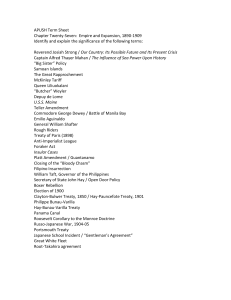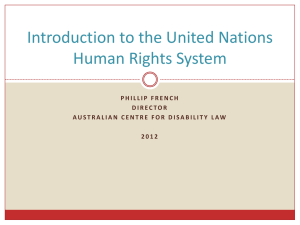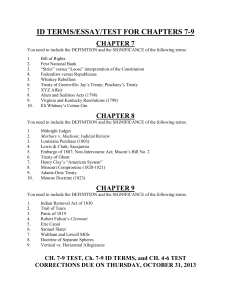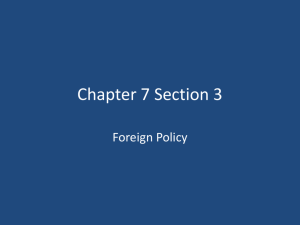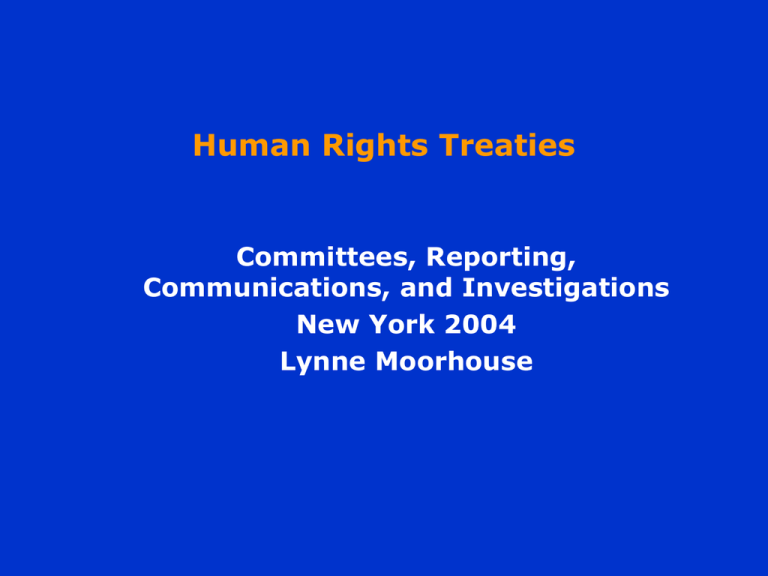
Human Rights Treaties
Committees, Reporting,
Communications, and Investigations
New York 2004
Lynne Moorhouse
Effects of Treaty Obligations
• In becoming party to a treaty, State undertakes
binding legal obligation
– State must ensure conformity of national law with
treaty provisions
• Certain NGOs, OHCHR, Bilateral Aid Donors can assist
States in drafting national laws to give effect to treaty
provisions
– OLA has also started a technical assistance
programme
• State can sign treaty even if national law not in place
– VCLT 1969 requires that on ratification/accession
national laws must be capable of giving
effect to treaty that is in force
Depositary vs. Administrative
Functions
• S-G, as Depositary:
- Impartially interprets
final clauses
- Does not comment on
substantive provisions
in order to maintain
neutrality
- Will not look behind
proper instrument
• S-G, as Chief Administrative
Officer of United Nations:
- Designates monitoring of
treaty (other than depositary
functions) to other
competent secretariat units
- E.g. DAW, OHCHR
Human Rights Committees
• State implementation of many core human rights
treaties is monitored by committees
– "treaty monitoring bodies".
• Legal basis for the establishment of most treaty
bodies can be found in the treaties themselves.
Exception: the ICESCR, whose Committee was
later established by an ECOSOC resolution.
HR Treaties which have Committees
• International Covenant on Economic, Social and
Cultural Rights; (ICESCR)
• International Covenant on Civil and Political Rights;
(ICCPR)
• Committee against Torture; (CAT)
• Elimination of All Forms of Racial Discrimination;
(CERD)
• Rights of the Child; (CRC)
• Elimination of Discrimination of All Forms of
Discrimination against Women; (CEDAW)
• Protection of the Rights of All Migrant Workers and
Members of Their Families.
(entered into force on 1 July 2003)
Composition of Committee
• Treaty bodies are composed of independent
experts of recognized competence in the field of
human rights who are elected by States parties.
• All treaty bodies serviced by Office of the High
Commissioner for Human Rights in Geneva, except
CEDAW - serviced by the Division for the
Advancement of Women in New York.
REPORTING PROCEDURES
What does the Committee do?
Supports vulnerable groups against
heinous violations by States by:
monitoring and overseeing the
implementation of the Convention by
States parties
examining and considering reports
submitted by States parties
making suggestions and
recommendations
What does the Committee do?
(cont’d)
Committee never formally pronounces State
in violation of Convention: constructive
dialogue with States vs. adversarial process
Reports annually on its activities to the GA
through ECOSOC
May invite UN specialized agencies and NGOs
to submit reports
Purpose of Reporting
1. Ensure State party undertakes comprehensive
review of national legislation, administrative rules
and procedures to assure conformity with treaty
2. Ensure State party regularly monitors actual
situation to assess the extent to which the various
rights are being enjoyed by individuals
3. Provide governments a basis for elaboration of
policies for implementing treaties
Purpose of Reporting (cont’d)
4. Facilitate transparency of governmental policies
5. Encourage involvement of civil society in
formulation, implementation and review of policies
6. Provide a basis for State party and Committee to
evaluate progress on the realization of treaty
obligations
CEDAW Report Requirements
[Art.18.1]
• On legislative, judicial, administrative or other
measures adopted to give effect to the provisions
of the Convention and the progress made in this
respect
• Submit to the S-G for consideration of the
Committee
• Within 1 year after the EIF of the Convention for
the State
• Thereafter at least every 4 years and further
whenever the Committee so requests
CEDAW Reporting (cont’d)
[Art.18.2]
• Reports may indicate factors and difficulties
affecting the degree of fulfillment of obligations
under the present Convention
ICCPR Reporting
[Art. 40]
• On measures adopted which give effect to the
rights recognized under the provisions of the
Convention and the enjoyment of those rights
• Submit to the S-G for consideration of the
Committee
• Within 1 year of the EIF of the Covenant for the
State
• Thereafter whenever the Committee so requests
How does a State party report to the
Committee?
• By ratifying/acceding to a Convention, States
parties accept a legal obligation to submit timely
and complete reports
• Review Committees’ guidelines
• Many States fail to discharge this obligation
Human Rights Treaty Reporting
Problems
• Complexity of human rights system + burden of
reporting obligations
– Strains resources of Member States and of
Secretariat
– Benefits of current system not always clear
• Current structure of human rights committees
imposes difficult reporting demands on treaty
parties.
Human Rights Treaty Reporting
Problems (Cont’d)
• Problems arise from a lack of personnel,
experience and resources within the relevant
ministry or department.
• An independent expert in 1997 stated: "Nonreporting has reached chronic proportions ...
States ... either do not report at all, or report long
after the due date“
(E/CN.4/1997/74, paras. 112-113)
Two Measures to Alleviate the
Shortcomings of the Current System
1. Committees develop coordinated approach to
activities and standardize reporting requirements.
2. Each State should produce a single report
summarizing its adherence to the full range of
human rights treaties to which it is a party.
Reform Proposals: GA and S-G
• GA encouraged review of reporting procedures to
– develop coordinated approach
– streamline the reporting requirements
• GA requested the United Nations High Commissioner
for Human Rights to support this exercise
– GA Res. A/57/L.74
• The High Commissioner for Human Rights consults
with treaty bodies to submit recommendations
to S-G by September 2003
COMMUNICATIONS PROCEDURES
What else does the Committee do?
• Ensure that States are implementing the provisions
of the Convention by:
– Hearing and examining State-to-State
communications.
[CERD Art.11, ICCPR Art.41, CAT Art. 21, MWC Art. 76]
– Hear and examine communications from
Individuals who claim to be victims of a violation
by a State party.
[OPICCPR Art.1, OPCEDAW Art.2, CAT Art.22, CERD Art.14]
State-to-State Communications
E.g. ICCPR Art. 41.1
• Formal Acceptance
[Optional] Declaration recognizing the competence
of the Committee to hear
State-to-State communications
Must be signed by:
- Head of State, Head of Government, or
Minister of Foreign Affairs
State-to-State Communications
ICCPR Art. 41.1 (cont’d)
• Who can submit a communication?
“…a State party which has made a declaration
recognizing…the competence of the Committee”
will be received and considered.
• Whom can the communication concern?
“No communication shall be received by the
Committee if it concerns a State party which has
not made such a declaration.”
State-to-State Communications
ICCPR Art. 41.1 (cont’d)
• Last Resort
“The Committee shall deal with the matter…
only after it has ascertained that all available
domestic remedies have been exhausted…”
• Confidentiality
“The Committee shall hold closed meetings
when examining communications under this
article.”
Individual Communications
Mechanism
•
Four treaty bodies have established
procedures by which individual
communications may be submitted for
examination.
1. Human Rights Committee
2. Committee on the Elimination of All
Forms of Racial Discrimination
3. Committee Against Torture
4. Committee on the Elimination of
discrimination Against Women
Individual Communications
Mechanism (cont’d)
•
Individuals must be within the jurisdiction of States
that have formally accepted these procedures
Formal Acceptance of Competence of Committee
1) Declaration: must be signed by appropriate
authority [CERD Art.14, CAT Art.22]
2) Optional Protocol: separate instrument which
must be signed/ratified in addition to the
original treaty [CCPROP1, CEDAWOP]
Individual Communications
Mechanism (cont’d)
• Criteria for examination:
1) All domestic remedies must have been exhausted
2) The communication must not be anonymous
3) The communication must be about a violation of a
specific right provided for in the treaty under which
it is submitted
4) Communications cannot be considered if the same
matter is being examined under another
international procedure of investigation or
settlement
Powers of independent investigation
of the Committee
E.g. CAT (Art.20), E.g. OPCEDAW (Art.8)
• Article 20 of CAT: Committee can receive information
and institute inquiries on allegations of systematic
practice of torture in States Parties
– competence optional, i.e., at the time of ratifying or
acceding to the Convention, a State may declare
that it does not recognize it
• Procedure: confidential character and cooperative with
States Parties
• After inquiry, the Committee may include a summary
of the results in its annual report; otherwise, all the
work and documents are confidential
International Covenant on Civil
and Political Rights
State of Emergency
• Article 4.3 “Any State Party to the present
Covenant availing itself of the right of derogation
(due to state of emergency) shall notify
immediately the other States Parties to the present
Covenant, through the intermediary of the
Secretary-General of the UN, of the provisions
from which it has derogated and of the reasons by
which it was actuated. A further communication
shall be made, through the same intermediary, on
the date it terminates such derogation.”
ICCPR Art. 4 (3)
• Used by States during State of Emergency to
notify S-G of derogations under ICCPR
• S-G encourages immediacy of notification to
ensure prompt dissemination of information
Implementation/Reporting
Assistance
•
•
•
•
•
Office of the High Commissioner for Human Rights
Name: Jane Connors
Email jconnors@ohchr.org
Name: Jan Cedergren
Email jcedergren.hchr@unog.ch
• Division for the Advancement of Women
• Name: Carolyn Hannan
• Email: hannan@un.org
Copyright Notice
• Copyright 2003 by the United Nations. All rights
reserved. Printed in the United States of America.
No part of this publication may be reproduced,
stored in a retrieval system, or transmitted in any
form by any means, i.e., electronic, mechanical,
photocopying, recording, or otherwise, without the
written permission of the United Nations


